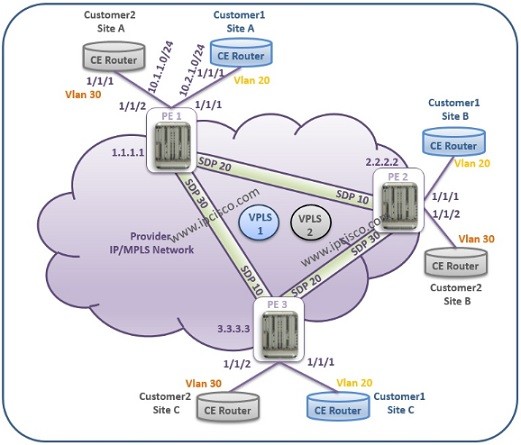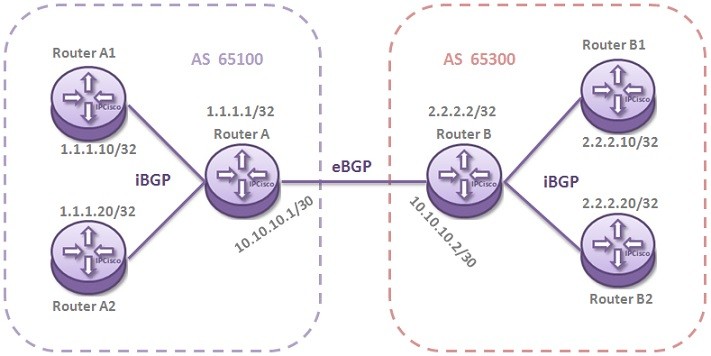Table of Contents
How to Configure VPRN on Nokia Service Routers?
In this post, we will focus on the configuration of VPRN Service on Nokia (Alcatel-Lucent) Service Routers. Here, We will use Alcatel-Lucent 7450 Service Router as a PE Router. Our Provider Routers will be Nokia (Alcatel-Lucent) 7750 Service Routers. But, there will be no configuration on P routers in this post. We assume that we have a proper Provider MPLS Core.
For VPRN Configuration, we will use the below topology:

To Test Yourself on Nokia Services, You Can Also Check Nokia Services Quiz Page
MP-BGP and BGP Configuration between
To Configure VPRN, firstly routing protocol configuration must be done. Then MP-BGP must be enabled between PEs. Firstly let’s cofigure MP-BGP.
PE1
PE1# configure router autonomous-system 64600
PE1# exit all
PE1# configure router bgp
PE1>config>router>bgp# group “multi-bgp”
PE1>config>router>bgp>group$ family vpn-ipv4
PE1>config>router>bgp>group$ peer-as 64600
PE1>config>router>bgp>group$ neighbour 2.2.2.2
PE1>config>router>bgp>group>neighbour$ local-address 1.1.1.1
PE1>config>router>bgp>group>neighbour$ exit all
PE1> config>router>bgp# info
group “multi-bgp”
family vpn-ipv4
peer-as 64600
neighbour 2.2.2.2
local-address 1.1.1.1
exit
exit
PE2
PE2# configure router autonomous-system 64600
PE2# exit all
PE2# configure router bgp
PE2>config>router>bgp# group “multi-bgp”
PE2>config>router>bgp>group$ family vpn-ipv4
PE2>config>router>bgp>group$ peer-as 64600
PE2>config>router>bgp>group$ neighbour 1.1.1.1
PE2>config>router>bgp>group>neighbour$ local-address 2.2.2.2
PE2>config>router>bgp>group>neighbour$ exit all
PE2> config>router>bgp# info
group “multi-bgp”
family vpn-ipv4
peer-as 64600
neighbour 1.1.1.1
local-address 2.2.2.2
exit
exit
To verify this, you can use, “show router bgp neighbour” command.
As an example for routing protocol configuration, I will give the configuration between Customer Routers and PE1 router.
PE1# configure service vprn 500
PE1>config>service>vprn# autonomous system 64600
PE1>config>service>vprn# bgp
PE1>config>service>vprn>bgp$ neighbour 10.1.1.2
PE1>config>service>vprn>bgp>neighbour$ peer-as 64601
PE1>config>service>vprn>bgp>neighbour$ exit all
PE1# configure service vprn 600
PE1>config>service>vprn# autonomous system 64600
PE1>config>service>vprn# bgp
PE1>config>service>vprn>bgp$ neighbour 10.2.1.2
PE1>config>service>vprn>bgp>neighbour$ peer-as 64602
PE1>config>service>vprn>bgp>neighbour$ exit all
CE1>config>router# bgp
CE1>config>router>bgp$ autonomous system 64601
CE1>config>router>bgp$ neighbour 10.1.1.1
CE1>config>router>bgp>neighbour$ peer-as 64600
CE1>config>router>bgp>neighbour$ exit all
CE2>config>router# bgp
CE1>config>router>bgp$ autonomous system 64602
CE2>config>router>bgp$ neighbour 10.2.1.1
CE2>config>router>bgp>neighbour$ peer-as 64600
CE2>config>router>bgp>neighbour$ exit all
In our example MP-BGP will be used between PE routers. Between CE and PE routers BGP will be used. Here, any other routing protocol can be used. But we prefer BGP. So CE and PE are BGP peers.
VPRN Configuration
1.Create Customer.
PE1# configure service customer 200 create
PE1>config>service>cust# description “Our VPRN Customer 1”
PE1>config>service> cust # exit
PE1>config>service# customer 300 create
PE1>config>service> cust # description “Our VPRN Customer 2”
PE1>config>service> cust # exit all
2.Create VPRN Services associated with Customer ID.
PE1# configure service
PE1>config>service> vprn 500 customer 200 create
PE1>config>service>vprn$ description “VPRN Service of Customer 500”
PE1>config>service>vprn$ router-id 1.1.1.1
PE1>config>service>vprn$ exit
PE1>config>service# vprn 600 customer 300 create
PE1>config>service>vprn$ description “VPRN Service of Customer 600”
PE1>config>service>vprn$ router-id 1.1.1.1
PE1>config>service>vprn$ exit
3.Configure Route Distinguisher and Route Target













Great staff and straight to the point .Thanks
One of the Best Website,which is providing full information about all vendors And Very clear explanation.Thank you.
Thank you very mych Mirsula. Always welcome:)
OK.